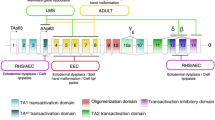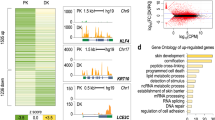Abstract.
The epidermis, the outer layer of the skin composed of keratinocytes, is a stratified epithelium that functions as a barrier to protect the organism from dehydration and external insults. The epidermis develops following the action of the transcription factor p63, amember of the p53 family of transcription factors. The Trp63 gene contains two promoters driving the production of distinct proteins, one with an N-terminal transactivation domain (TAp63) and one without (ΔNp63), although their relative contribution to epidermal development is not clearly established. Trp63 mutations are involved in the pathogenesis of several human diseases, phenotypically characterized by ectodermal dysplasia. In this review, we summarize the current advances that have been made in understanding the role of p63 in epidermal morphogenesis.
Similar content being viewed by others
Author information
Authors and Affiliations
Corresponding author
Additional information
Received 7 March 2008; received after revision 3 May 2008; accepted 6 May 2008
Rights and permissions
About this article
Cite this article
Candi, E., Cipollone, R., Rivetti di Val Cervo, P. et al. p63 in epithelial development. Cell. Mol. Life Sci. 65, 3126–3133 (2008). https://doi.org/10.1007/s00018-008-8119-x
Published:
Issue Date:
DOI: https://doi.org/10.1007/s00018-008-8119-x




